Internal Combustion Engine Components
VerifiedAdded on 2020/04/13
|13
|2974
|48
AI Summary
This assignment delves into the fundamental components of an internal combustion engine. It defines and explains the functions of essential parts such as pistons, crossheads, and crankshafts. The text utilizes diagrams to illustrate each component's role in the engine's operation. The references provided suggest a focus on mechanical engineering and shipbuilding.
Contribute Materials
Your contribution can guide someone’s learning journey. Share your
documents today.
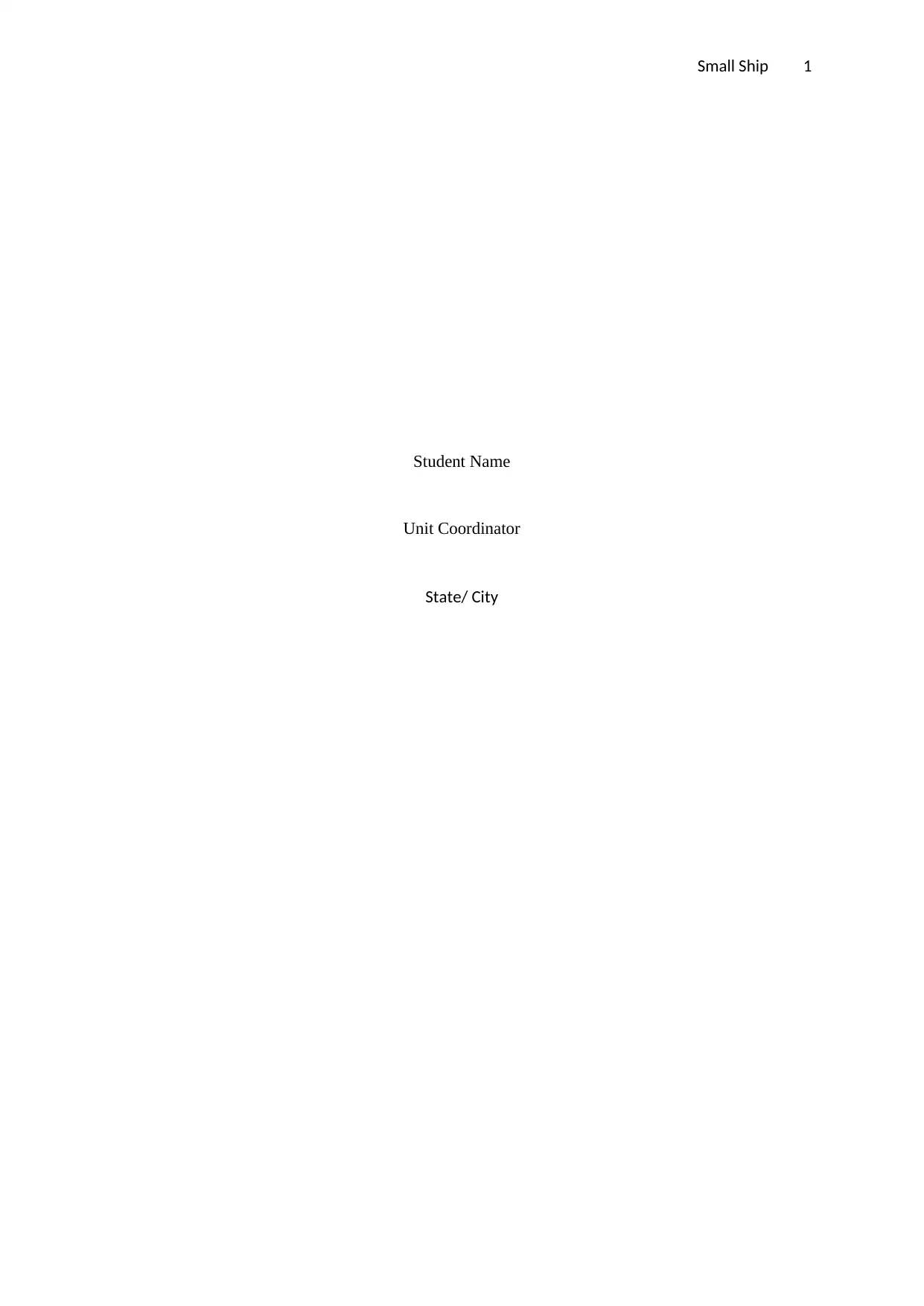
Small Ship 1
Student Name
Unit Coordinator
State/ City
Student Name
Unit Coordinator
State/ City
Secure Best Marks with AI Grader
Need help grading? Try our AI Grader for instant feedback on your assignments.
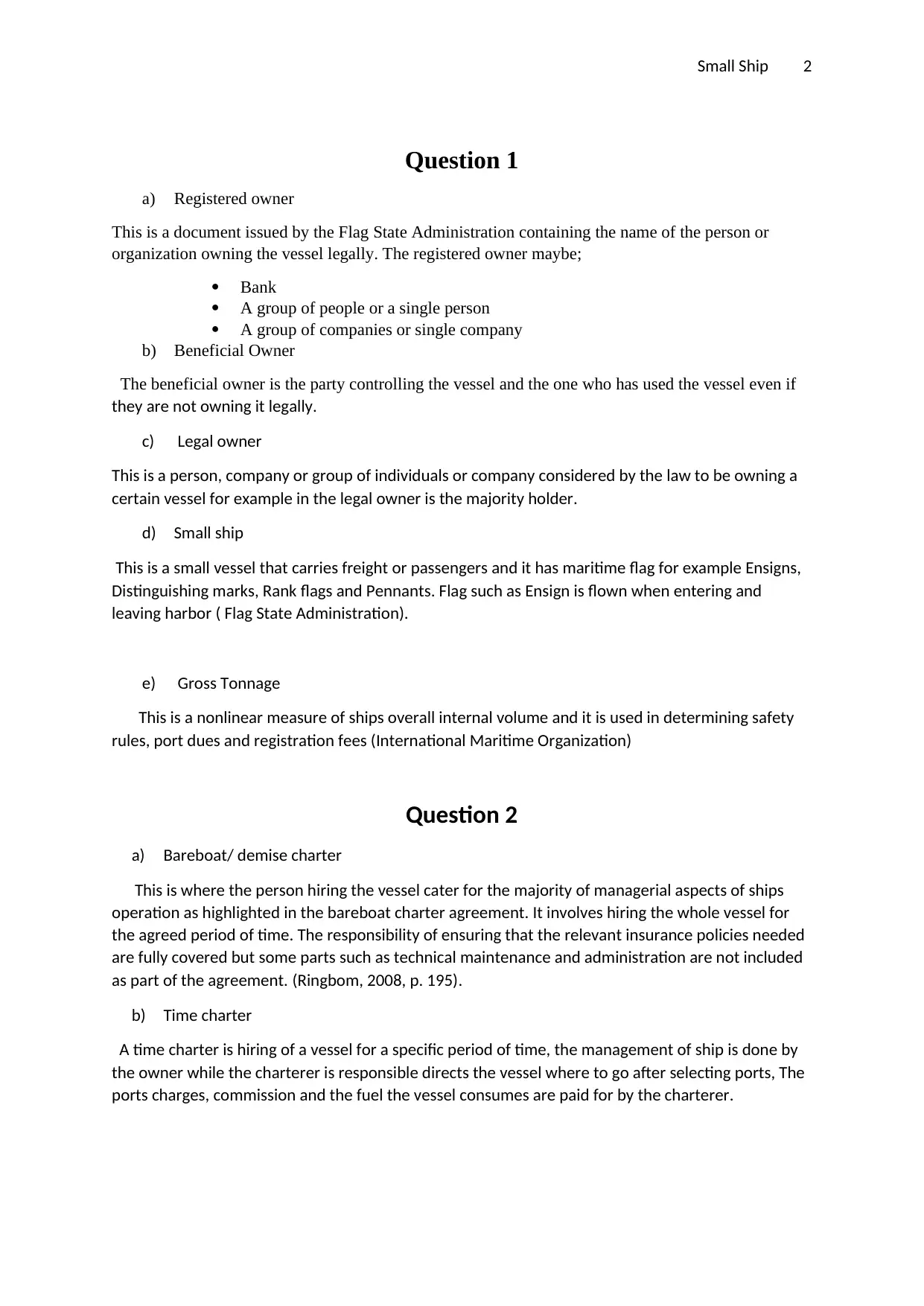
Small Ship 2
Question 1
a) Registered owner
This is a document issued by the Flag State Administration containing the name of the person or
organization owning the vessel legally. The registered owner maybe;
Bank
A group of people or a single person
A group of companies or single company
b) Beneficial Owner
The beneficial owner is the party controlling the vessel and the one who has used the vessel even if
they are not owning it legally.
c) Legal owner
This is a person, company or group of individuals or company considered by the law to be owning a
certain vessel for example in the legal owner is the majority holder.
d) Small ship
This is a small vessel that carries freight or passengers and it has maritime flag for example Ensigns,
Distinguishing marks, Rank flags and Pennants. Flag such as Ensign is flown when entering and
leaving harbor ( Flag State Administration).
e) Gross Tonnage
This is a nonlinear measure of ships overall internal volume and it is used in determining safety
rules, port dues and registration fees (International Maritime Organization)
Question 2
a) Bareboat/ demise charter
This is where the person hiring the vessel cater for the majority of managerial aspects of ships
operation as highlighted in the bareboat charter agreement. It involves hiring the whole vessel for
the agreed period of time. The responsibility of ensuring that the relevant insurance policies needed
are fully covered but some parts such as technical maintenance and administration are not included
as part of the agreement. (Ringbom, 2008, p. 195).
b) Time charter
A time charter is hiring of a vessel for a specific period of time, the management of ship is done by
the owner while the charterer is responsible directs the vessel where to go after selecting ports, The
ports charges, commission and the fuel the vessel consumes are paid for by the charterer.
Question 1
a) Registered owner
This is a document issued by the Flag State Administration containing the name of the person or
organization owning the vessel legally. The registered owner maybe;
Bank
A group of people or a single person
A group of companies or single company
b) Beneficial Owner
The beneficial owner is the party controlling the vessel and the one who has used the vessel even if
they are not owning it legally.
c) Legal owner
This is a person, company or group of individuals or company considered by the law to be owning a
certain vessel for example in the legal owner is the majority holder.
d) Small ship
This is a small vessel that carries freight or passengers and it has maritime flag for example Ensigns,
Distinguishing marks, Rank flags and Pennants. Flag such as Ensign is flown when entering and
leaving harbor ( Flag State Administration).
e) Gross Tonnage
This is a nonlinear measure of ships overall internal volume and it is used in determining safety
rules, port dues and registration fees (International Maritime Organization)
Question 2
a) Bareboat/ demise charter
This is where the person hiring the vessel cater for the majority of managerial aspects of ships
operation as highlighted in the bareboat charter agreement. It involves hiring the whole vessel for
the agreed period of time. The responsibility of ensuring that the relevant insurance policies needed
are fully covered but some parts such as technical maintenance and administration are not included
as part of the agreement. (Ringbom, 2008, p. 195).
b) Time charter
A time charter is hiring of a vessel for a specific period of time, the management of ship is done by
the owner while the charterer is responsible directs the vessel where to go after selecting ports, The
ports charges, commission and the fuel the vessel consumes are paid for by the charterer.
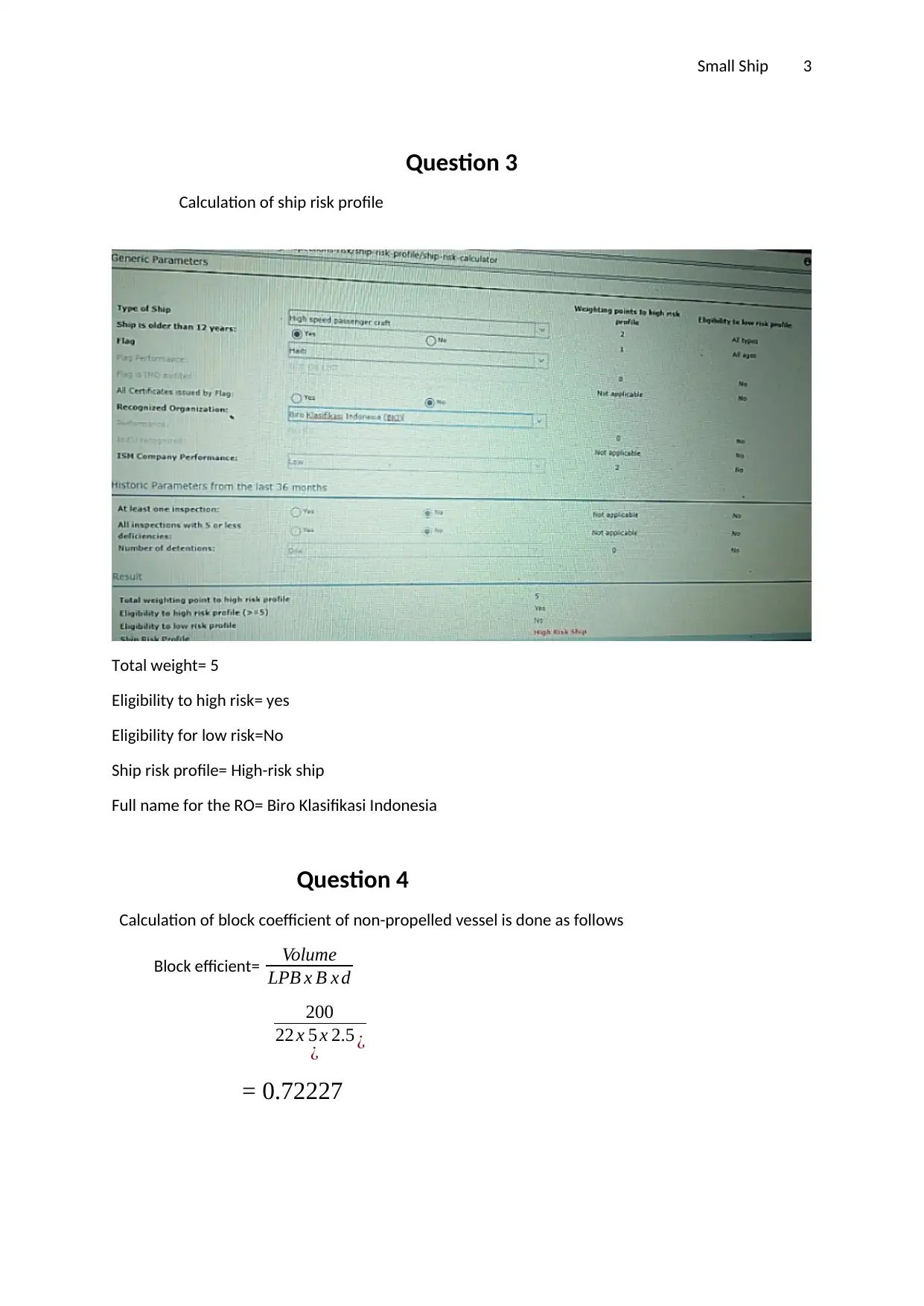
Small Ship 3
Question 3
Calculation of ship risk profile
Total weight= 5
Eligibility to high risk= yes
Eligibility for low risk=No
Ship risk profile= High-risk ship
Full name for the RO= Biro Klasifikasi Indonesia
Question 4
Calculation of block coefficient of non-propelled vessel is done as follows
Block efficient= Volume
LPB x B x d
200
22 x 5 x 2.5
¿ ¿
= 0.72227
Question 3
Calculation of ship risk profile
Total weight= 5
Eligibility to high risk= yes
Eligibility for low risk=No
Ship risk profile= High-risk ship
Full name for the RO= Biro Klasifikasi Indonesia
Question 4
Calculation of block coefficient of non-propelled vessel is done as follows
Block efficient= Volume
LPB x B x d
200
22 x 5 x 2.5
¿ ¿
= 0.72227
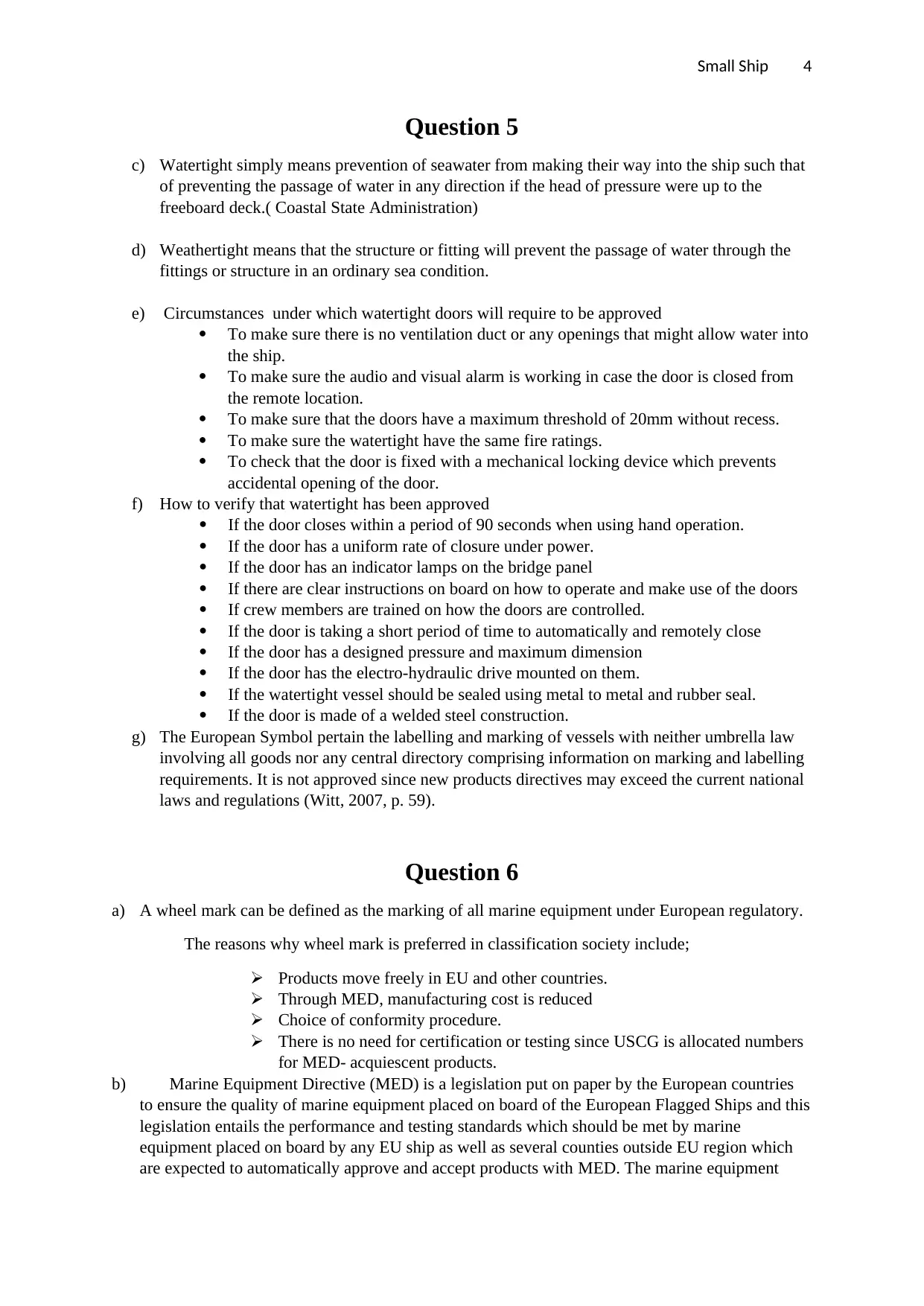
Small Ship 4
Question 5
c) Watertight simply means prevention of seawater from making their way into the ship such that
of preventing the passage of water in any direction if the head of pressure were up to the
freeboard deck.( Coastal State Administration)
d) Weathertight means that the structure or fitting will prevent the passage of water through the
fittings or structure in an ordinary sea condition.
e) Circumstances under which watertight doors will require to be approved
To make sure there is no ventilation duct or any openings that might allow water into
the ship.
To make sure the audio and visual alarm is working in case the door is closed from
the remote location.
To make sure that the doors have a maximum threshold of 20mm without recess.
To make sure the watertight have the same fire ratings.
To check that the door is fixed with a mechanical locking device which prevents
accidental opening of the door.
f) How to verify that watertight has been approved
If the door closes within a period of 90 seconds when using hand operation.
If the door has a uniform rate of closure under power.
If the door has an indicator lamps on the bridge panel
If there are clear instructions on board on how to operate and make use of the doors
If crew members are trained on how the doors are controlled.
If the door is taking a short period of time to automatically and remotely close
If the door has a designed pressure and maximum dimension
If the door has the electro-hydraulic drive mounted on them.
If the watertight vessel should be sealed using metal to metal and rubber seal.
If the door is made of a welded steel construction.
g) The European Symbol pertain the labelling and marking of vessels with neither umbrella law
involving all goods nor any central directory comprising information on marking and labelling
requirements. It is not approved since new products directives may exceed the current national
laws and regulations (Witt, 2007, p. 59).
Question 6
a) A wheel mark can be defined as the marking of all marine equipment under European regulatory.
The reasons why wheel mark is preferred in classification society include;
Products move freely in EU and other countries.
Through MED, manufacturing cost is reduced
Choice of conformity procedure.
There is no need for certification or testing since USCG is allocated numbers
for MED- acquiescent products.
b) Marine Equipment Directive (MED) is a legislation put on paper by the European countries
to ensure the quality of marine equipment placed on board of the European Flagged Ships and this
legislation entails the performance and testing standards which should be met by marine
equipment placed on board by any EU ship as well as several counties outside EU region which
are expected to automatically approve and accept products with MED. The marine equipment
Question 5
c) Watertight simply means prevention of seawater from making their way into the ship such that
of preventing the passage of water in any direction if the head of pressure were up to the
freeboard deck.( Coastal State Administration)
d) Weathertight means that the structure or fitting will prevent the passage of water through the
fittings or structure in an ordinary sea condition.
e) Circumstances under which watertight doors will require to be approved
To make sure there is no ventilation duct or any openings that might allow water into
the ship.
To make sure the audio and visual alarm is working in case the door is closed from
the remote location.
To make sure that the doors have a maximum threshold of 20mm without recess.
To make sure the watertight have the same fire ratings.
To check that the door is fixed with a mechanical locking device which prevents
accidental opening of the door.
f) How to verify that watertight has been approved
If the door closes within a period of 90 seconds when using hand operation.
If the door has a uniform rate of closure under power.
If the door has an indicator lamps on the bridge panel
If there are clear instructions on board on how to operate and make use of the doors
If crew members are trained on how the doors are controlled.
If the door is taking a short period of time to automatically and remotely close
If the door has a designed pressure and maximum dimension
If the door has the electro-hydraulic drive mounted on them.
If the watertight vessel should be sealed using metal to metal and rubber seal.
If the door is made of a welded steel construction.
g) The European Symbol pertain the labelling and marking of vessels with neither umbrella law
involving all goods nor any central directory comprising information on marking and labelling
requirements. It is not approved since new products directives may exceed the current national
laws and regulations (Witt, 2007, p. 59).
Question 6
a) A wheel mark can be defined as the marking of all marine equipment under European regulatory.
The reasons why wheel mark is preferred in classification society include;
Products move freely in EU and other countries.
Through MED, manufacturing cost is reduced
Choice of conformity procedure.
There is no need for certification or testing since USCG is allocated numbers
for MED- acquiescent products.
b) Marine Equipment Directive (MED) is a legislation put on paper by the European countries
to ensure the quality of marine equipment placed on board of the European Flagged Ships and this
legislation entails the performance and testing standards which should be met by marine
equipment placed on board by any EU ship as well as several counties outside EU region which
are expected to automatically approve and accept products with MED. The marine equipment
Secure Best Marks with AI Grader
Need help grading? Try our AI Grader for instant feedback on your assignments.
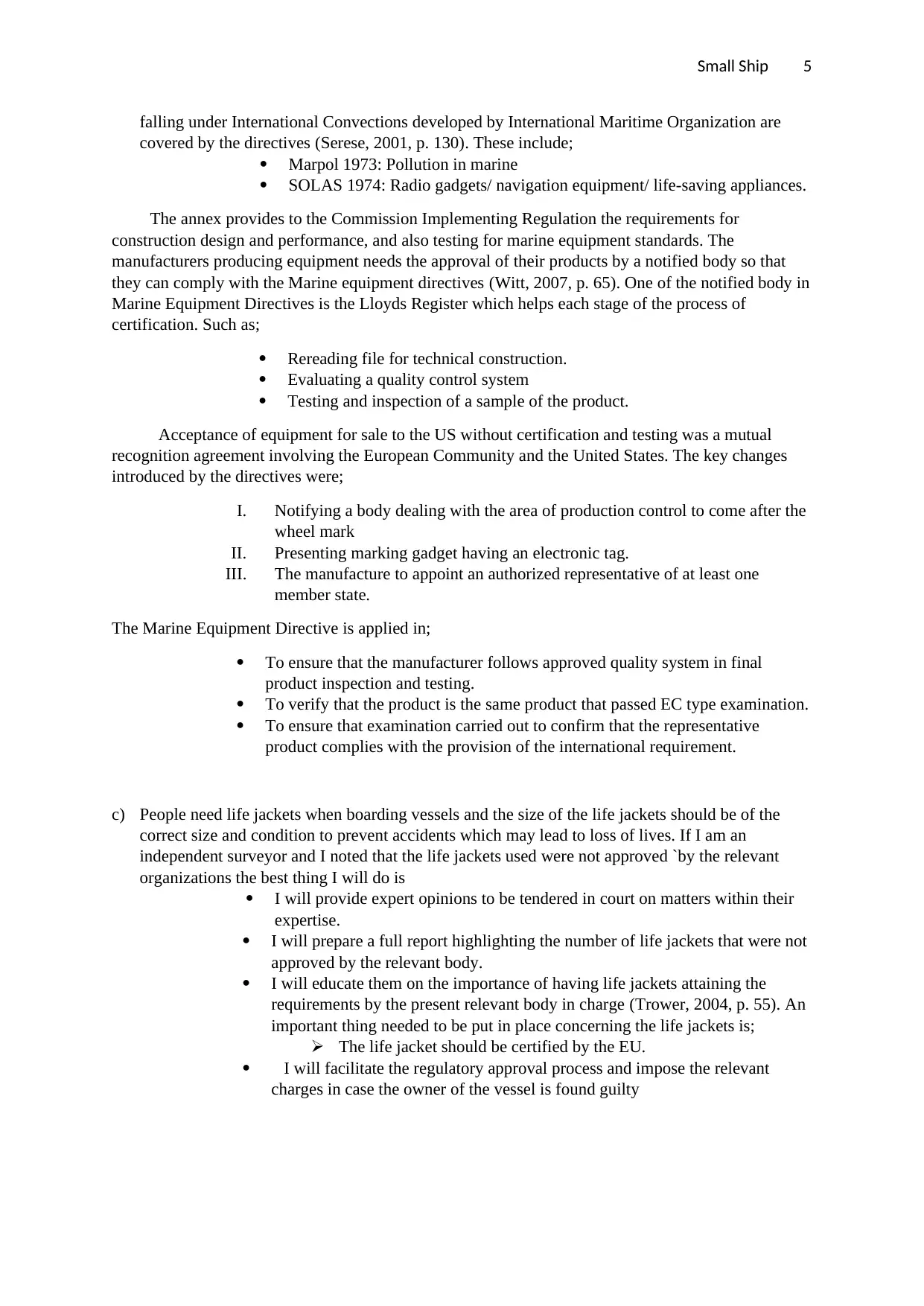
Small Ship 5
falling under International Convections developed by International Maritime Organization are
covered by the directives (Serese, 2001, p. 130). These include;
Marpol 1973: Pollution in marine
SOLAS 1974: Radio gadgets/ navigation equipment/ life-saving appliances.
The annex provides to the Commission Implementing Regulation the requirements for
construction design and performance, and also testing for marine equipment standards. The
manufacturers producing equipment needs the approval of their products by a notified body so that
they can comply with the Marine equipment directives (Witt, 2007, p. 65). One of the notified body in
Marine Equipment Directives is the Lloyds Register which helps each stage of the process of
certification. Such as;
Rereading file for technical construction.
Evaluating a quality control system
Testing and inspection of a sample of the product.
Acceptance of equipment for sale to the US without certification and testing was a mutual
recognition agreement involving the European Community and the United States. The key changes
introduced by the directives were;
I. Notifying a body dealing with the area of production control to come after the
wheel mark
II. Presenting marking gadget having an electronic tag.
III. The manufacture to appoint an authorized representative of at least one
member state.
The Marine Equipment Directive is applied in;
To ensure that the manufacturer follows approved quality system in final
product inspection and testing.
To verify that the product is the same product that passed EC type examination.
To ensure that examination carried out to confirm that the representative
product complies with the provision of the international requirement.
c) People need life jackets when boarding vessels and the size of the life jackets should be of the
correct size and condition to prevent accidents which may lead to loss of lives. If I am an
independent surveyor and I noted that the life jackets used were not approved `by the relevant
organizations the best thing I will do is
I will provide expert opinions to be tendered in court on matters within their
expertise.
I will prepare a full report highlighting the number of life jackets that were not
approved by the relevant body.
I will educate them on the importance of having life jackets attaining the
requirements by the present relevant body in charge (Trower, 2004, p. 55). An
important thing needed to be put in place concerning the life jackets is;
The life jacket should be certified by the EU.
I will facilitate the regulatory approval process and impose the relevant
charges in case the owner of the vessel is found guilty
falling under International Convections developed by International Maritime Organization are
covered by the directives (Serese, 2001, p. 130). These include;
Marpol 1973: Pollution in marine
SOLAS 1974: Radio gadgets/ navigation equipment/ life-saving appliances.
The annex provides to the Commission Implementing Regulation the requirements for
construction design and performance, and also testing for marine equipment standards. The
manufacturers producing equipment needs the approval of their products by a notified body so that
they can comply with the Marine equipment directives (Witt, 2007, p. 65). One of the notified body in
Marine Equipment Directives is the Lloyds Register which helps each stage of the process of
certification. Such as;
Rereading file for technical construction.
Evaluating a quality control system
Testing and inspection of a sample of the product.
Acceptance of equipment for sale to the US without certification and testing was a mutual
recognition agreement involving the European Community and the United States. The key changes
introduced by the directives were;
I. Notifying a body dealing with the area of production control to come after the
wheel mark
II. Presenting marking gadget having an electronic tag.
III. The manufacture to appoint an authorized representative of at least one
member state.
The Marine Equipment Directive is applied in;
To ensure that the manufacturer follows approved quality system in final
product inspection and testing.
To verify that the product is the same product that passed EC type examination.
To ensure that examination carried out to confirm that the representative
product complies with the provision of the international requirement.
c) People need life jackets when boarding vessels and the size of the life jackets should be of the
correct size and condition to prevent accidents which may lead to loss of lives. If I am an
independent surveyor and I noted that the life jackets used were not approved `by the relevant
organizations the best thing I will do is
I will provide expert opinions to be tendered in court on matters within their
expertise.
I will prepare a full report highlighting the number of life jackets that were not
approved by the relevant body.
I will educate them on the importance of having life jackets attaining the
requirements by the present relevant body in charge (Trower, 2004, p. 55). An
important thing needed to be put in place concerning the life jackets is;
The life jacket should be certified by the EU.
I will facilitate the regulatory approval process and impose the relevant
charges in case the owner of the vessel is found guilty
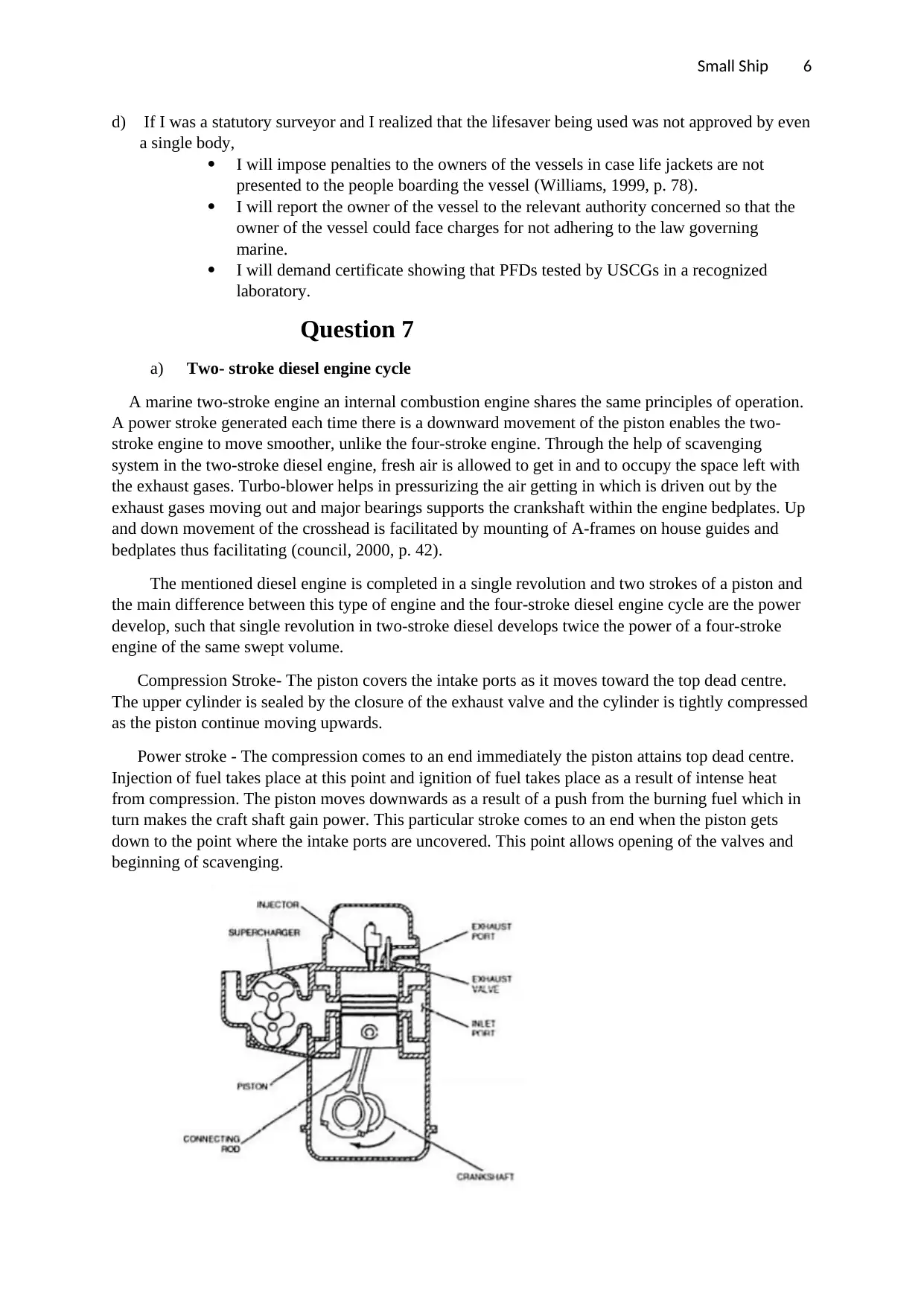
Small Ship 6
d) If I was a statutory surveyor and I realized that the lifesaver being used was not approved by even
a single body,
I will impose penalties to the owners of the vessels in case life jackets are not
presented to the people boarding the vessel (Williams, 1999, p. 78).
I will report the owner of the vessel to the relevant authority concerned so that the
owner of the vessel could face charges for not adhering to the law governing
marine.
I will demand certificate showing that PFDs tested by USCGs in a recognized
laboratory.
Question 7
a) Two- stroke diesel engine cycle
A marine two-stroke engine an internal combustion engine shares the same principles of operation.
A power stroke generated each time there is a downward movement of the piston enables the two-
stroke engine to move smoother, unlike the four-stroke engine. Through the help of scavenging
system in the two-stroke diesel engine, fresh air is allowed to get in and to occupy the space left with
the exhaust gases. Turbo-blower helps in pressurizing the air getting in which is driven out by the
exhaust gases moving out and major bearings supports the crankshaft within the engine bedplates. Up
and down movement of the crosshead is facilitated by mounting of A-frames on house guides and
bedplates thus facilitating (council, 2000, p. 42).
The mentioned diesel engine is completed in a single revolution and two strokes of a piston and
the main difference between this type of engine and the four-stroke diesel engine cycle are the power
develop, such that single revolution in two-stroke diesel develops twice the power of a four-stroke
engine of the same swept volume.
Compression Stroke- The piston covers the intake ports as it moves toward the top dead centre.
The upper cylinder is sealed by the closure of the exhaust valve and the cylinder is tightly compressed
as the piston continue moving upwards.
Power stroke - The compression comes to an end immediately the piston attains top dead centre.
Injection of fuel takes place at this point and ignition of fuel takes place as a result of intense heat
from compression. The piston moves downwards as a result of a push from the burning fuel which in
turn makes the craft shaft gain power. This particular stroke comes to an end when the piston gets
down to the point where the intake ports are uncovered. This point allows opening of the valves and
beginning of scavenging.
d) If I was a statutory surveyor and I realized that the lifesaver being used was not approved by even
a single body,
I will impose penalties to the owners of the vessels in case life jackets are not
presented to the people boarding the vessel (Williams, 1999, p. 78).
I will report the owner of the vessel to the relevant authority concerned so that the
owner of the vessel could face charges for not adhering to the law governing
marine.
I will demand certificate showing that PFDs tested by USCGs in a recognized
laboratory.
Question 7
a) Two- stroke diesel engine cycle
A marine two-stroke engine an internal combustion engine shares the same principles of operation.
A power stroke generated each time there is a downward movement of the piston enables the two-
stroke engine to move smoother, unlike the four-stroke engine. Through the help of scavenging
system in the two-stroke diesel engine, fresh air is allowed to get in and to occupy the space left with
the exhaust gases. Turbo-blower helps in pressurizing the air getting in which is driven out by the
exhaust gases moving out and major bearings supports the crankshaft within the engine bedplates. Up
and down movement of the crosshead is facilitated by mounting of A-frames on house guides and
bedplates thus facilitating (council, 2000, p. 42).
The mentioned diesel engine is completed in a single revolution and two strokes of a piston and
the main difference between this type of engine and the four-stroke diesel engine cycle are the power
develop, such that single revolution in two-stroke diesel develops twice the power of a four-stroke
engine of the same swept volume.
Compression Stroke- The piston covers the intake ports as it moves toward the top dead centre.
The upper cylinder is sealed by the closure of the exhaust valve and the cylinder is tightly compressed
as the piston continue moving upwards.
Power stroke - The compression comes to an end immediately the piston attains top dead centre.
Injection of fuel takes place at this point and ignition of fuel takes place as a result of intense heat
from compression. The piston moves downwards as a result of a push from the burning fuel which in
turn makes the craft shaft gain power. This particular stroke comes to an end when the piston gets
down to the point where the intake ports are uncovered. This point allows opening of the valves and
beginning of scavenging.
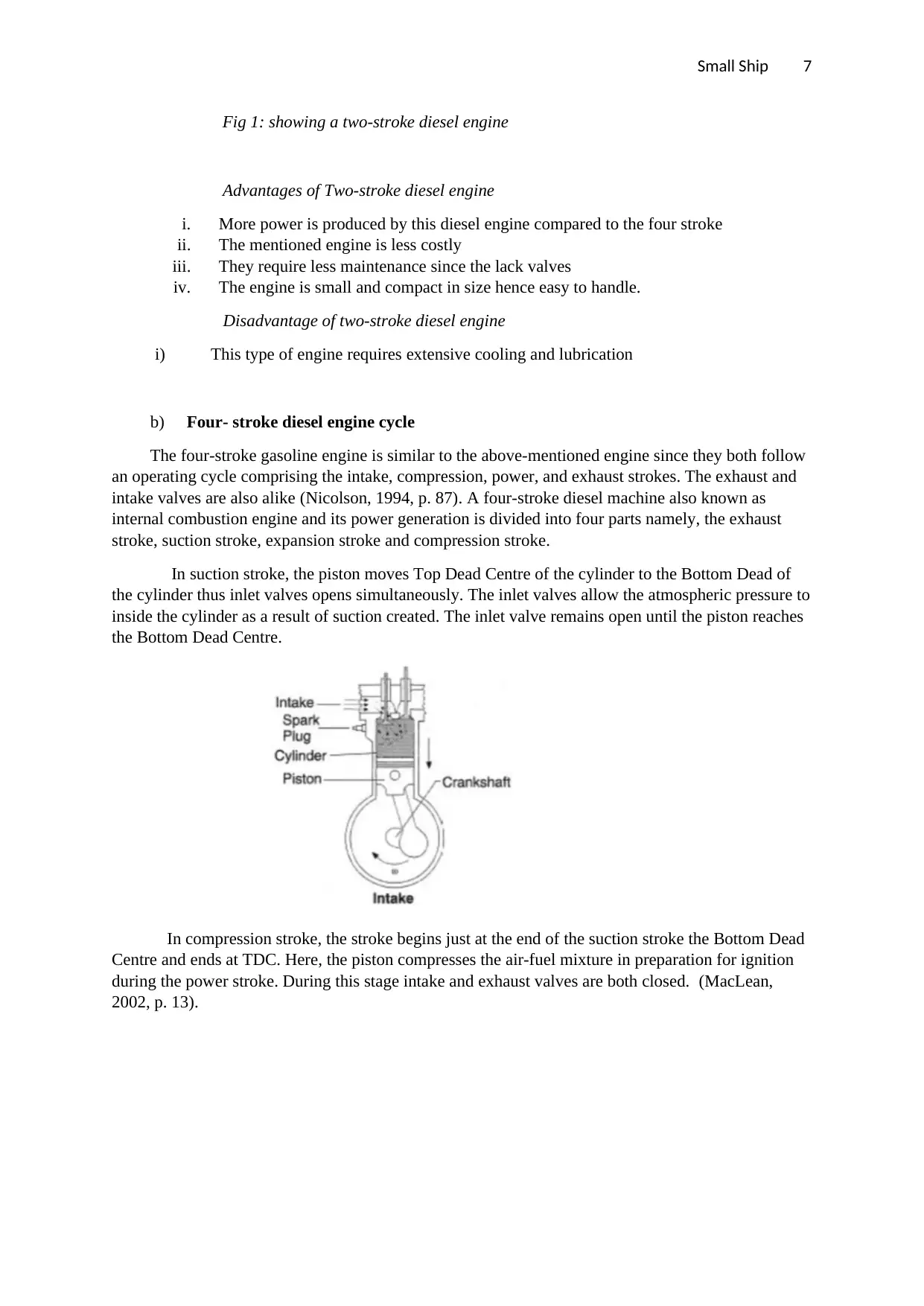
Small Ship 7
Fig 1: showing a two-stroke diesel engine
Advantages of Two-stroke diesel engine
i. More power is produced by this diesel engine compared to the four stroke
ii. The mentioned engine is less costly
iii. They require less maintenance since the lack valves
iv. The engine is small and compact in size hence easy to handle.
Disadvantage of two-stroke diesel engine
i) This type of engine requires extensive cooling and lubrication
b) Four- stroke diesel engine cycle
The four-stroke gasoline engine is similar to the above-mentioned engine since they both follow
an operating cycle comprising the intake, compression, power, and exhaust strokes. The exhaust and
intake valves are also alike (Nicolson, 1994, p. 87). A four-stroke diesel machine also known as
internal combustion engine and its power generation is divided into four parts namely, the exhaust
stroke, suction stroke, expansion stroke and compression stroke.
In suction stroke, the piston moves Top Dead Centre of the cylinder to the Bottom Dead of
the cylinder thus inlet valves opens simultaneously. The inlet valves allow the atmospheric pressure to
inside the cylinder as a result of suction created. The inlet valve remains open until the piston reaches
the Bottom Dead Centre.
In compression stroke, the stroke begins just at the end of the suction stroke the Bottom Dead
Centre and ends at TDC. Here, the piston compresses the air-fuel mixture in preparation for ignition
during the power stroke. During this stage intake and exhaust valves are both closed. (MacLean,
2002, p. 13).
Fig 1: showing a two-stroke diesel engine
Advantages of Two-stroke diesel engine
i. More power is produced by this diesel engine compared to the four stroke
ii. The mentioned engine is less costly
iii. They require less maintenance since the lack valves
iv. The engine is small and compact in size hence easy to handle.
Disadvantage of two-stroke diesel engine
i) This type of engine requires extensive cooling and lubrication
b) Four- stroke diesel engine cycle
The four-stroke gasoline engine is similar to the above-mentioned engine since they both follow
an operating cycle comprising the intake, compression, power, and exhaust strokes. The exhaust and
intake valves are also alike (Nicolson, 1994, p. 87). A four-stroke diesel machine also known as
internal combustion engine and its power generation is divided into four parts namely, the exhaust
stroke, suction stroke, expansion stroke and compression stroke.
In suction stroke, the piston moves Top Dead Centre of the cylinder to the Bottom Dead of
the cylinder thus inlet valves opens simultaneously. The inlet valves allow the atmospheric pressure to
inside the cylinder as a result of suction created. The inlet valve remains open until the piston reaches
the Bottom Dead Centre.
In compression stroke, the stroke begins just at the end of the suction stroke the Bottom Dead
Centre and ends at TDC. Here, the piston compresses the air-fuel mixture in preparation for ignition
during the power stroke. During this stage intake and exhaust valves are both closed. (MacLean,
2002, p. 13).
Paraphrase This Document
Need a fresh take? Get an instant paraphrase of this document with our AI Paraphraser
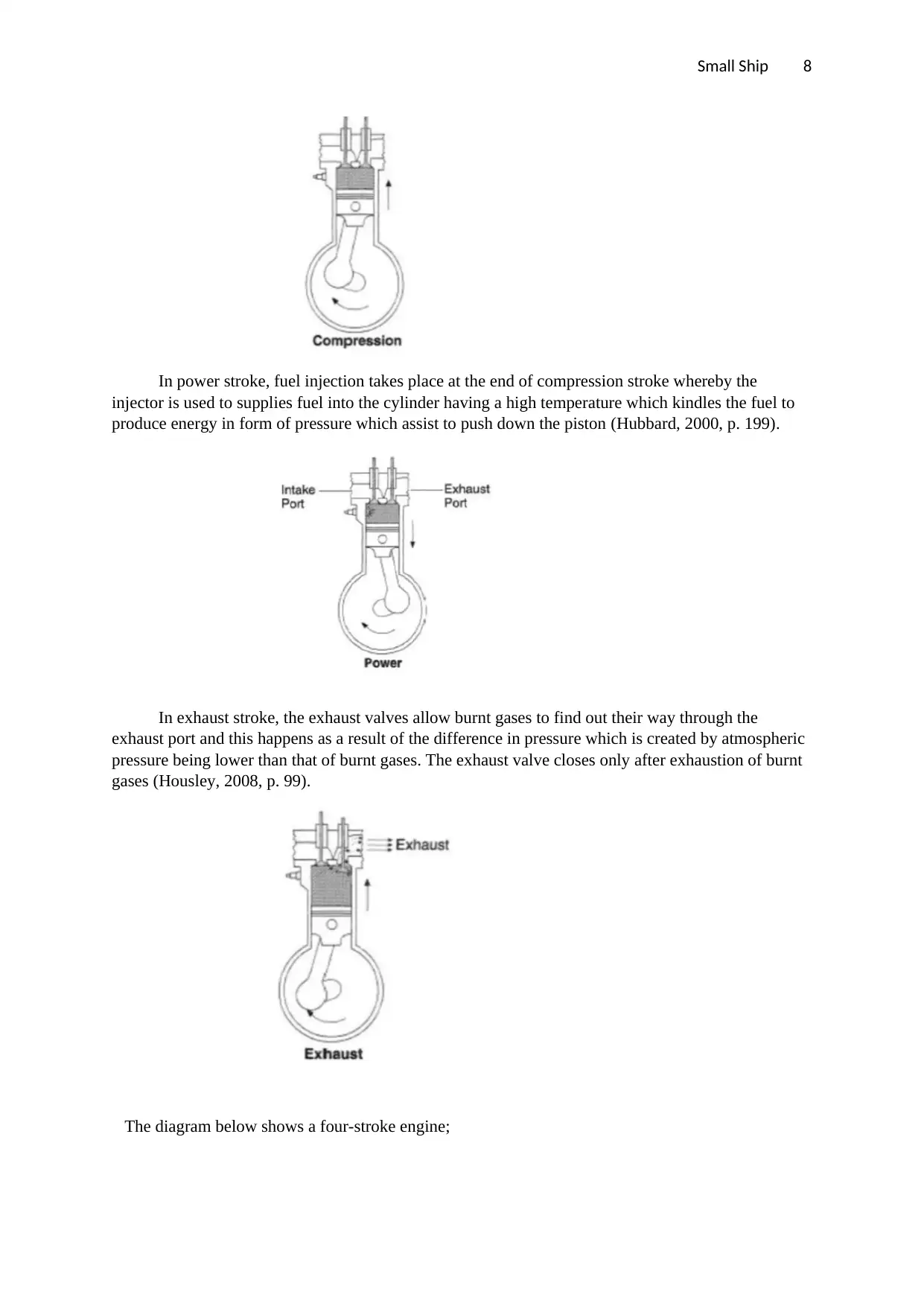
Small Ship 8
In power stroke, fuel injection takes place at the end of compression stroke whereby the
injector is used to supplies fuel into the cylinder having a high temperature which kindles the fuel to
produce energy in form of pressure which assist to push down the piston (Hubbard, 2000, p. 199).
In exhaust stroke, the exhaust valves allow burnt gases to find out their way through the
exhaust port and this happens as a result of the difference in pressure which is created by atmospheric
pressure being lower than that of burnt gases. The exhaust valve closes only after exhaustion of burnt
gases (Housley, 2008, p. 99).
The diagram below shows a four-stroke engine;
In power stroke, fuel injection takes place at the end of compression stroke whereby the
injector is used to supplies fuel into the cylinder having a high temperature which kindles the fuel to
produce energy in form of pressure which assist to push down the piston (Hubbard, 2000, p. 199).
In exhaust stroke, the exhaust valves allow burnt gases to find out their way through the
exhaust port and this happens as a result of the difference in pressure which is created by atmospheric
pressure being lower than that of burnt gases. The exhaust valve closes only after exhaustion of burnt
gases (Housley, 2008, p. 99).
The diagram below shows a four-stroke engine;
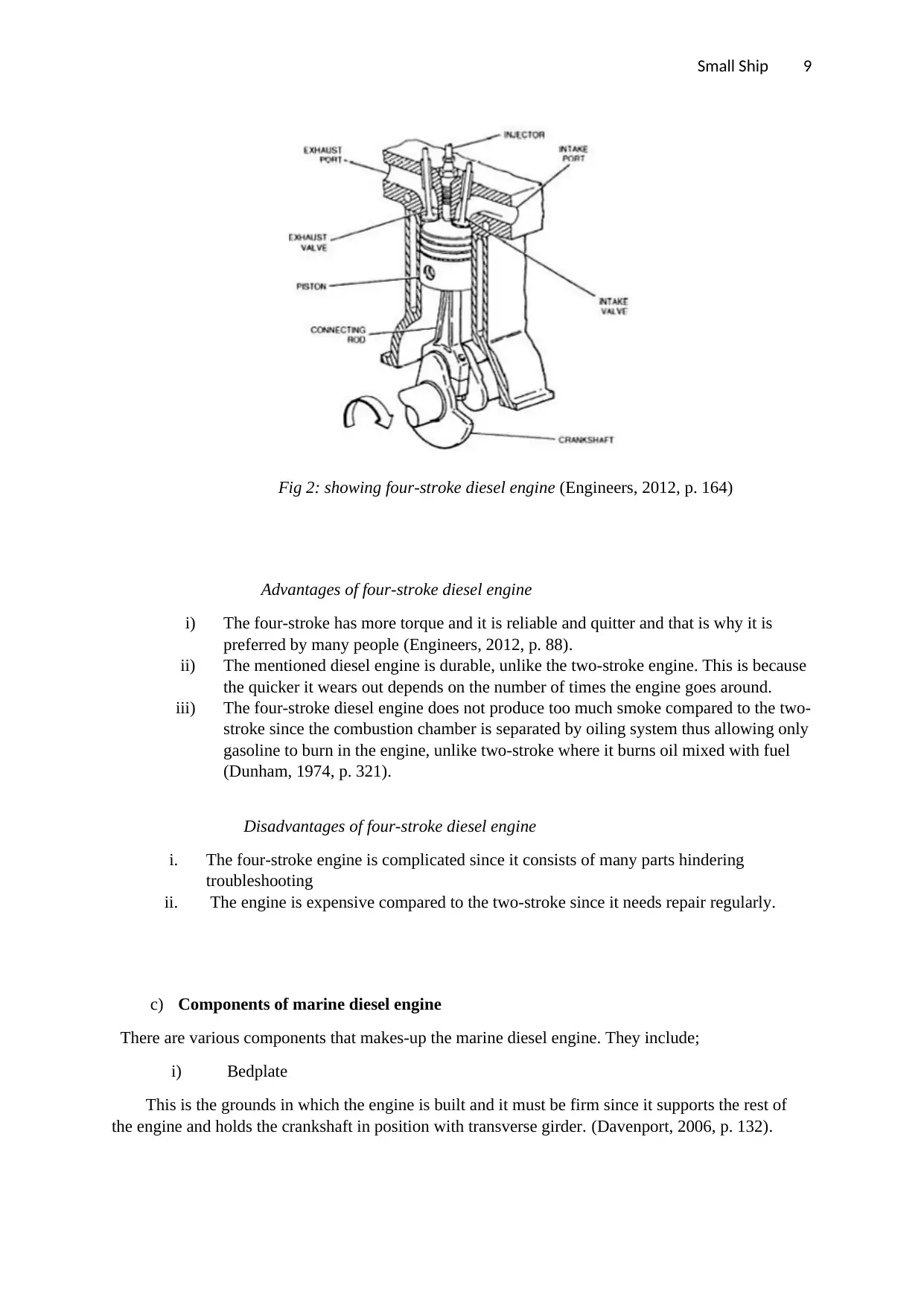
Small Ship 9
Fig 2: showing four-stroke diesel engine (Engineers, 2012, p. 164)
Advantages of four-stroke diesel engine
i) The four-stroke has more torque and it is reliable and quitter and that is why it is
preferred by many people (Engineers, 2012, p. 88).
ii) The mentioned diesel engine is durable, unlike the two-stroke engine. This is because
the quicker it wears out depends on the number of times the engine goes around.
iii) The four-stroke diesel engine does not produce too much smoke compared to the two-
stroke since the combustion chamber is separated by oiling system thus allowing only
gasoline to burn in the engine, unlike two-stroke where it burns oil mixed with fuel
(Dunham, 1974, p. 321).
Disadvantages of four-stroke diesel engine
i. The four-stroke engine is complicated since it consists of many parts hindering
troubleshooting
ii. The engine is expensive compared to the two-stroke since it needs repair regularly.
c) Components of marine diesel engine
There are various components that makes-up the marine diesel engine. They include;
i) Bedplate
This is the grounds in which the engine is built and it must be firm since it supports the rest of
the engine and holds the crankshaft in position with transverse girder. (Davenport, 2006, p. 132).
Fig 2: showing four-stroke diesel engine (Engineers, 2012, p. 164)
Advantages of four-stroke diesel engine
i) The four-stroke has more torque and it is reliable and quitter and that is why it is
preferred by many people (Engineers, 2012, p. 88).
ii) The mentioned diesel engine is durable, unlike the two-stroke engine. This is because
the quicker it wears out depends on the number of times the engine goes around.
iii) The four-stroke diesel engine does not produce too much smoke compared to the two-
stroke since the combustion chamber is separated by oiling system thus allowing only
gasoline to burn in the engine, unlike two-stroke where it burns oil mixed with fuel
(Dunham, 1974, p. 321).
Disadvantages of four-stroke diesel engine
i. The four-stroke engine is complicated since it consists of many parts hindering
troubleshooting
ii. The engine is expensive compared to the two-stroke since it needs repair regularly.
c) Components of marine diesel engine
There are various components that makes-up the marine diesel engine. They include;
i) Bedplate
This is the grounds in which the engine is built and it must be firm since it supports the rest of
the engine and holds the crankshaft in position with transverse girder. (Davenport, 2006, p. 132).
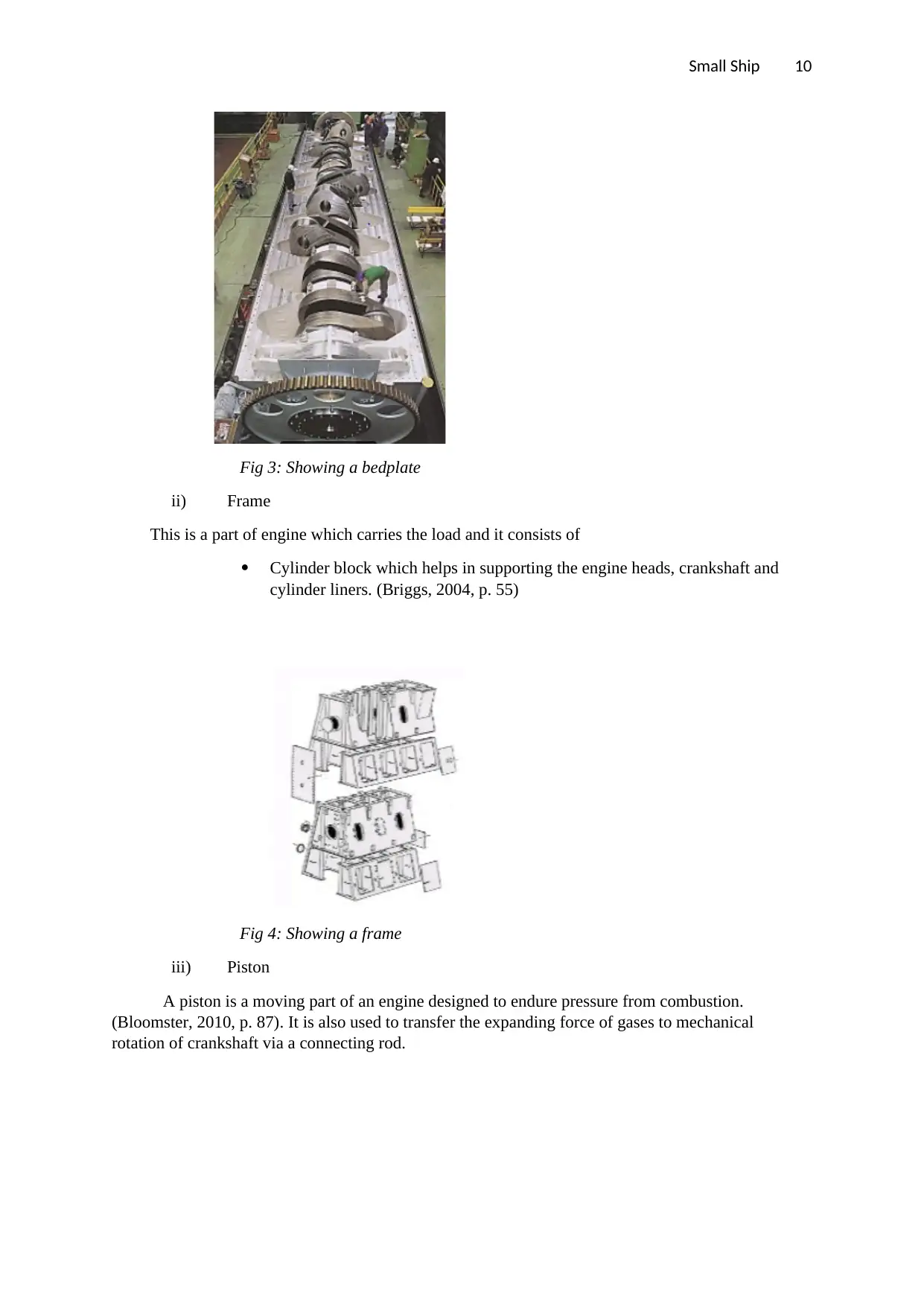
Small Ship 10
Fig 3: Showing a bedplate
ii) Frame
This is a part of engine which carries the load and it consists of
Cylinder block which helps in supporting the engine heads, crankshaft and
cylinder liners. (Briggs, 2004, p. 55)
Fig 4: Showing a frame
iii) Piston
A piston is a moving part of an engine designed to endure pressure from combustion.
(Bloomster, 2010, p. 87). It is also used to transfer the expanding force of gases to mechanical
rotation of crankshaft via a connecting rod.
Fig 3: Showing a bedplate
ii) Frame
This is a part of engine which carries the load and it consists of
Cylinder block which helps in supporting the engine heads, crankshaft and
cylinder liners. (Briggs, 2004, p. 55)
Fig 4: Showing a frame
iii) Piston
A piston is a moving part of an engine designed to endure pressure from combustion.
(Bloomster, 2010, p. 87). It is also used to transfer the expanding force of gases to mechanical
rotation of crankshaft via a connecting rod.
Secure Best Marks with AI Grader
Need help grading? Try our AI Grader for instant feedback on your assignments.
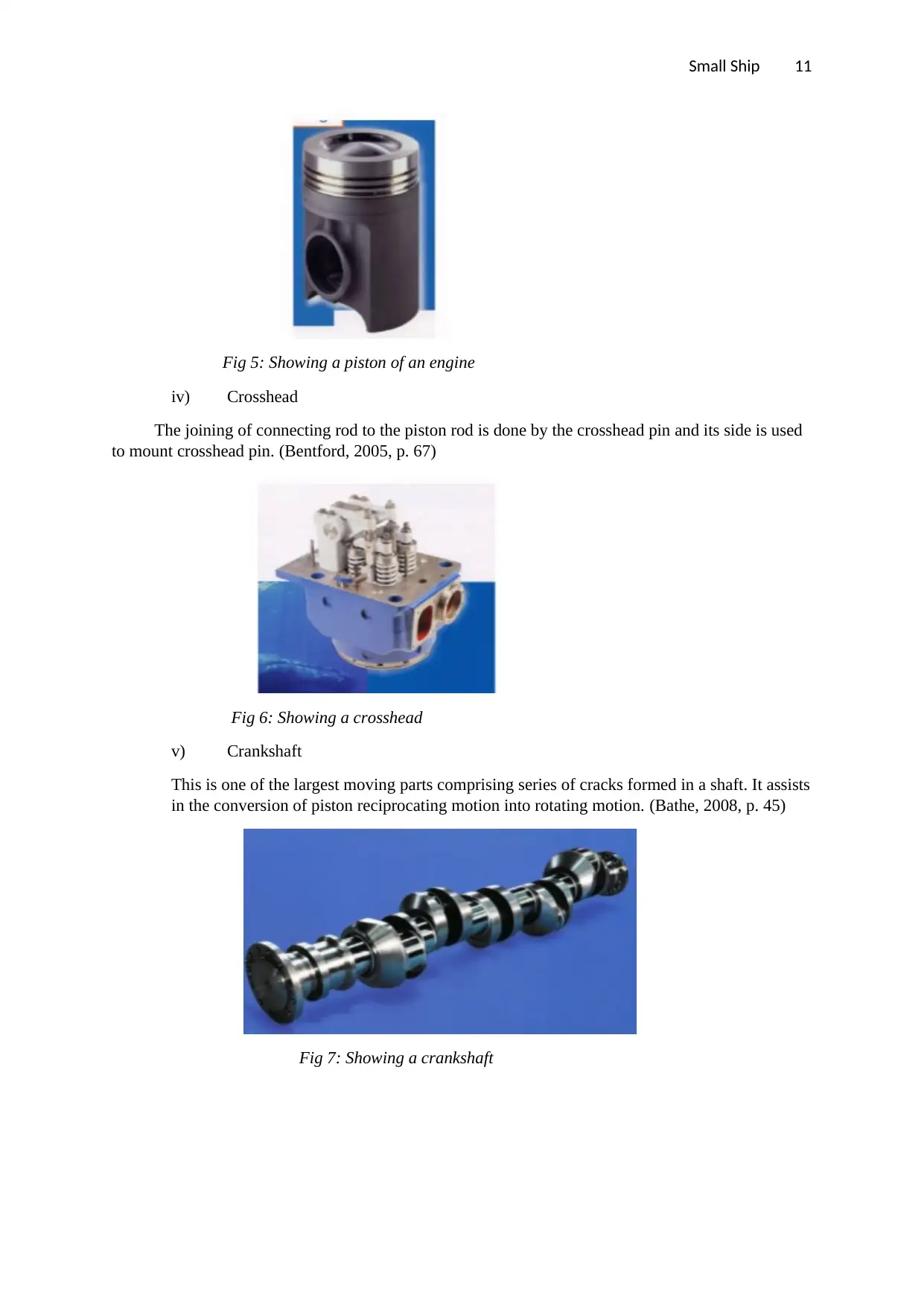
Small Ship 11
Fig 5: Showing a piston of an engine
iv) Crosshead
The joining of connecting rod to the piston rod is done by the crosshead pin and its side is used
to mount crosshead pin. (Bentford, 2005, p. 67)
Fig 6: Showing a crosshead
v) Crankshaft
This is one of the largest moving parts comprising series of cracks formed in a shaft. It assists
in the conversion of piston reciprocating motion into rotating motion. (Bathe, 2008, p. 45)
Fig 7: Showing a crankshaft
Fig 5: Showing a piston of an engine
iv) Crosshead
The joining of connecting rod to the piston rod is done by the crosshead pin and its side is used
to mount crosshead pin. (Bentford, 2005, p. 67)
Fig 6: Showing a crosshead
v) Crankshaft
This is one of the largest moving parts comprising series of cracks formed in a shaft. It assists
in the conversion of piston reciprocating motion into rotating motion. (Bathe, 2008, p. 45)
Fig 7: Showing a crankshaft
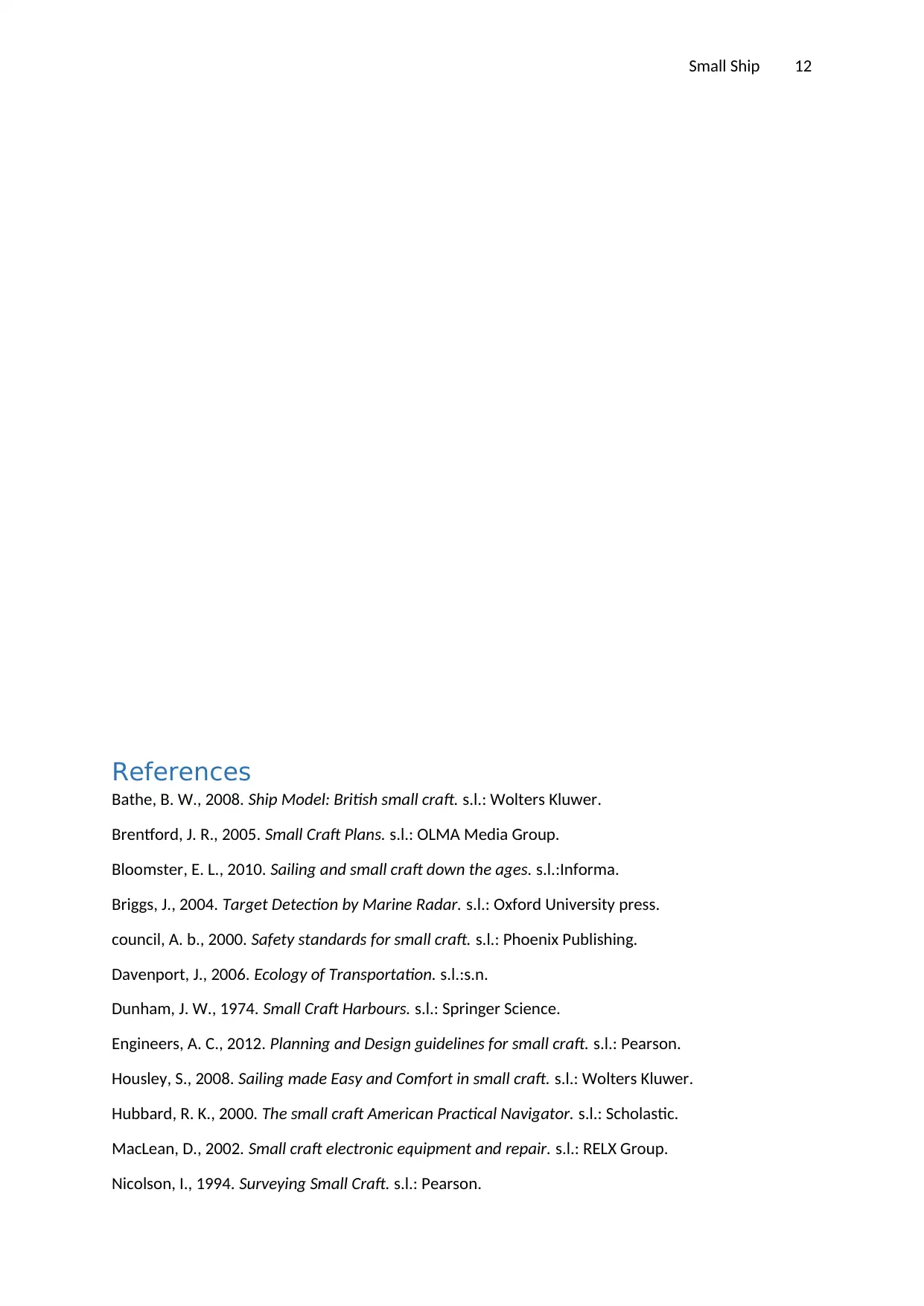
Small Ship 12
References
Bathe, B. W., 2008. Ship Model: British small craft. s.l.: Wolters Kluwer.
Brentford, J. R., 2005. Small Craft Plans. s.l.: OLMA Media Group.
Bloomster, E. L., 2010. Sailing and small craft down the ages. s.l.:Informa.
Briggs, J., 2004. Target Detection by Marine Radar. s.l.: Oxford University press.
council, A. b., 2000. Safety standards for small craft. s.l.: Phoenix Publishing.
Davenport, J., 2006. Ecology of Transportation. s.l.:s.n.
Dunham, J. W., 1974. Small Craft Harbours. s.l.: Springer Science.
Engineers, A. C., 2012. Planning and Design guidelines for small craft. s.l.: Pearson.
Housley, S., 2008. Sailing made Easy and Comfort in small craft. s.l.: Wolters Kluwer.
Hubbard, R. K., 2000. The small craft American Practical Navigator. s.l.: Scholastic.
MacLean, D., 2002. Small craft electronic equipment and repair. s.l.: RELX Group.
Nicolson, I., 1994. Surveying Small Craft. s.l.: Pearson.
References
Bathe, B. W., 2008. Ship Model: British small craft. s.l.: Wolters Kluwer.
Brentford, J. R., 2005. Small Craft Plans. s.l.: OLMA Media Group.
Bloomster, E. L., 2010. Sailing and small craft down the ages. s.l.:Informa.
Briggs, J., 2004. Target Detection by Marine Radar. s.l.: Oxford University press.
council, A. b., 2000. Safety standards for small craft. s.l.: Phoenix Publishing.
Davenport, J., 2006. Ecology of Transportation. s.l.:s.n.
Dunham, J. W., 1974. Small Craft Harbours. s.l.: Springer Science.
Engineers, A. C., 2012. Planning and Design guidelines for small craft. s.l.: Pearson.
Housley, S., 2008. Sailing made Easy and Comfort in small craft. s.l.: Wolters Kluwer.
Hubbard, R. K., 2000. The small craft American Practical Navigator. s.l.: Scholastic.
MacLean, D., 2002. Small craft electronic equipment and repair. s.l.: RELX Group.
Nicolson, I., 1994. Surveying Small Craft. s.l.: Pearson.
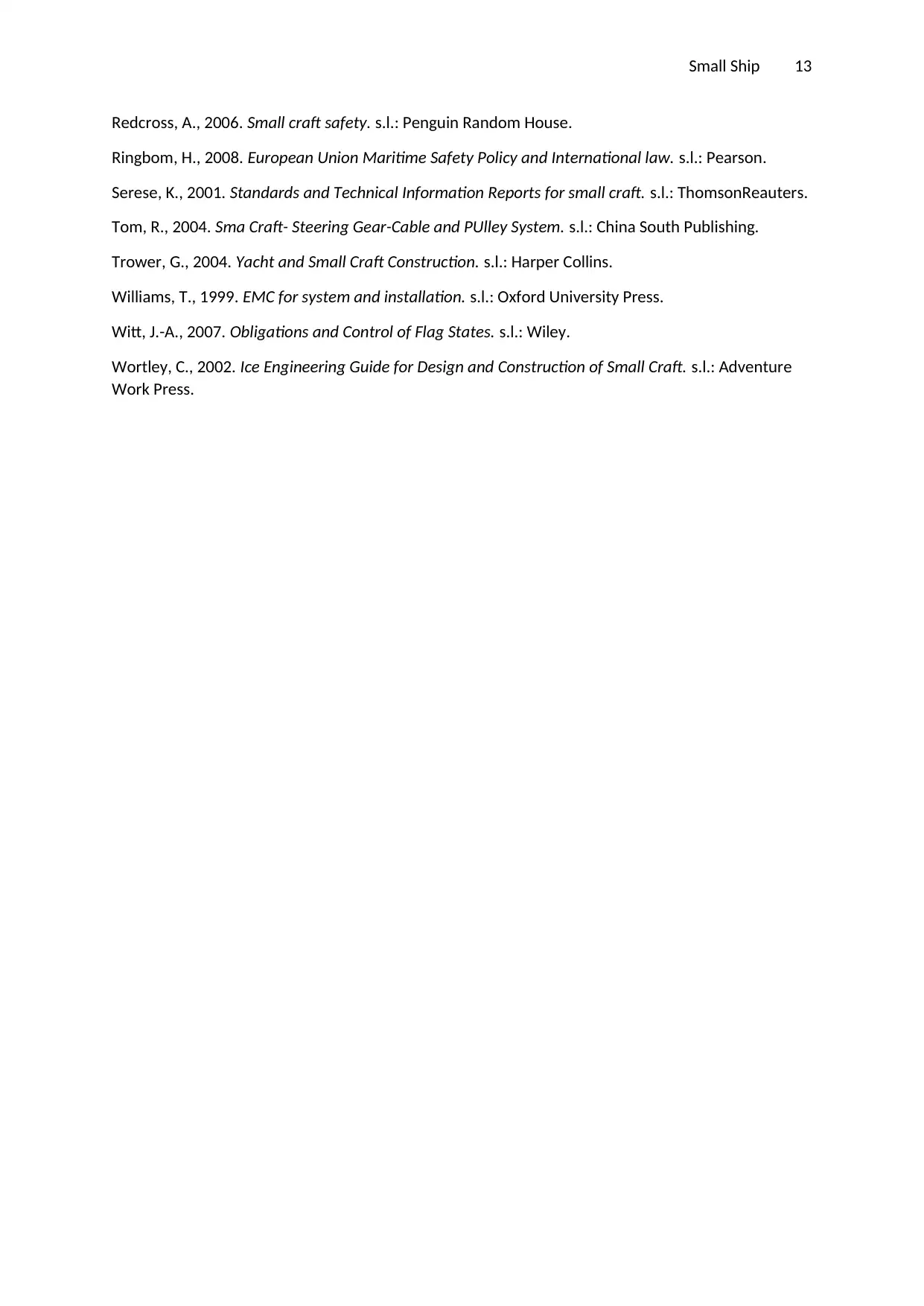
Small Ship 13
Redcross, A., 2006. Small craft safety. s.l.: Penguin Random House.
Ringbom, H., 2008. European Union Maritime Safety Policy and International law. s.l.: Pearson.
Serese, K., 2001. Standards and Technical Information Reports for small craft. s.l.: ThomsonReauters.
Tom, R., 2004. Sma Craft- Steering Gear-Cable and PUlley System. s.l.: China South Publishing.
Trower, G., 2004. Yacht and Small Craft Construction. s.l.: Harper Collins.
Williams, T., 1999. EMC for system and installation. s.l.: Oxford University Press.
Witt, J.-A., 2007. Obligations and Control of Flag States. s.l.: Wiley.
Wortley, C., 2002. Ice Engineering Guide for Design and Construction of Small Craft. s.l.: Adventure
Work Press.
Redcross, A., 2006. Small craft safety. s.l.: Penguin Random House.
Ringbom, H., 2008. European Union Maritime Safety Policy and International law. s.l.: Pearson.
Serese, K., 2001. Standards and Technical Information Reports for small craft. s.l.: ThomsonReauters.
Tom, R., 2004. Sma Craft- Steering Gear-Cable and PUlley System. s.l.: China South Publishing.
Trower, G., 2004. Yacht and Small Craft Construction. s.l.: Harper Collins.
Williams, T., 1999. EMC for system and installation. s.l.: Oxford University Press.
Witt, J.-A., 2007. Obligations and Control of Flag States. s.l.: Wiley.
Wortley, C., 2002. Ice Engineering Guide for Design and Construction of Small Craft. s.l.: Adventure
Work Press.
1 out of 13
Your All-in-One AI-Powered Toolkit for Academic Success.
+13062052269
info@desklib.com
Available 24*7 on WhatsApp / Email
![[object Object]](/_next/static/media/star-bottom.7253800d.svg)
Unlock your academic potential
© 2024 | Zucol Services PVT LTD | All rights reserved.